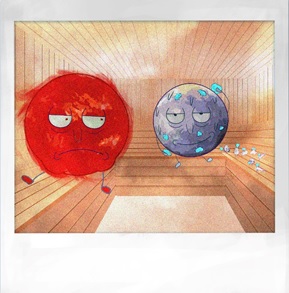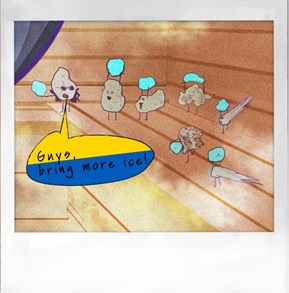Space dust, asteroids and comets can account for all water on Mercury
Mercury harbors water ice in the shadows of the steepest craters around its poles. But it is unclear how those water molecules ended up on Mercury. Now a new simulation by scientists from the University of Groningen and SRON Netherlands Institute for Sp ace Research shows that incoming minor bodies such as asteroids, comets and dust particles carry enough water to account for all the ice sheets present. The study could form the basis for new research on water in exoplanetary systems. Publication in Icarus on April 19th.

Dust particles
We have known for a few decades that Mercury harbors water. It seems obvious that this can only be in the form of water vapor. After all, the planet has no atmosphere, which rules out a liquid due to a lack of pressure. And Mercury is almost three times closer to the Sun than the Earth is, so water ice doesn't seem likely either. But the planet has steep craters at high latitudes, which contain troughs that are forever captured in darkness, only illuminated by the dimly glowing band of the Milky Way against the backdrop of an eternal black sky. These eerie places are home to ice sheets many meters thick, on the closest planet to the Sun. Now the question remains: how did those water molecules end up on Mercury?
First author Kateryna Frantseva (SRON/RUG) has developed an algorithm that simulates meteorite impacts in the form of asteroids, comets and interplanetary dust particles. It turns out that over the course of a billion years these bodies bring enough water to Mercury’s surface to explain the amount that we currently see.

Heaviest load
Frantseva: 'We cannot rule out endogenous sources of water such as volcanic activity and outgassing from the crust and mantle, but this shows that we don't need anything other than impacts from minor bodies to explain the water we see on Mercury.' The simulation shows that interplanetary dust particles carry by far the heaviest load, with over ten thousand kilograms per year. In comparison, asteroids and comets deliver yearly each about a thousand kilograms.
The simulation provides a basis for new theoretical models for water delivery to exoplanets, planets outside our Solar System. These can be compared to future observations, for example from the recently launched James Webb telescope, in which astronomers might be able to spot water signatures in the spectrum of light that asteroid belts in exoplanetary systems emit while re-radiating light from their host star.
Reference: Kateryna Frantseva,David Nesvorný, Michael Mueller, Floris F.S.van der Tak, Inge Loesten Kate and Petr Pokorný: Exogenous delivery of water to Mercury. Icarus, 19 April 2022 (first online 16 March).
First author Kateryna Frantseva is a Ukrainian scientist based in The Netherlands. She is part of a network of Ukrainian volunteers working in Dutch academia that support their home country. To help out, you can donate online.
Text: SRON
More news
-
11 December 2025
Stormy planets and an unexpected atmosphere
-
09 December 2025
University of Groningen Professor at COP30: ‘There is always drama’
